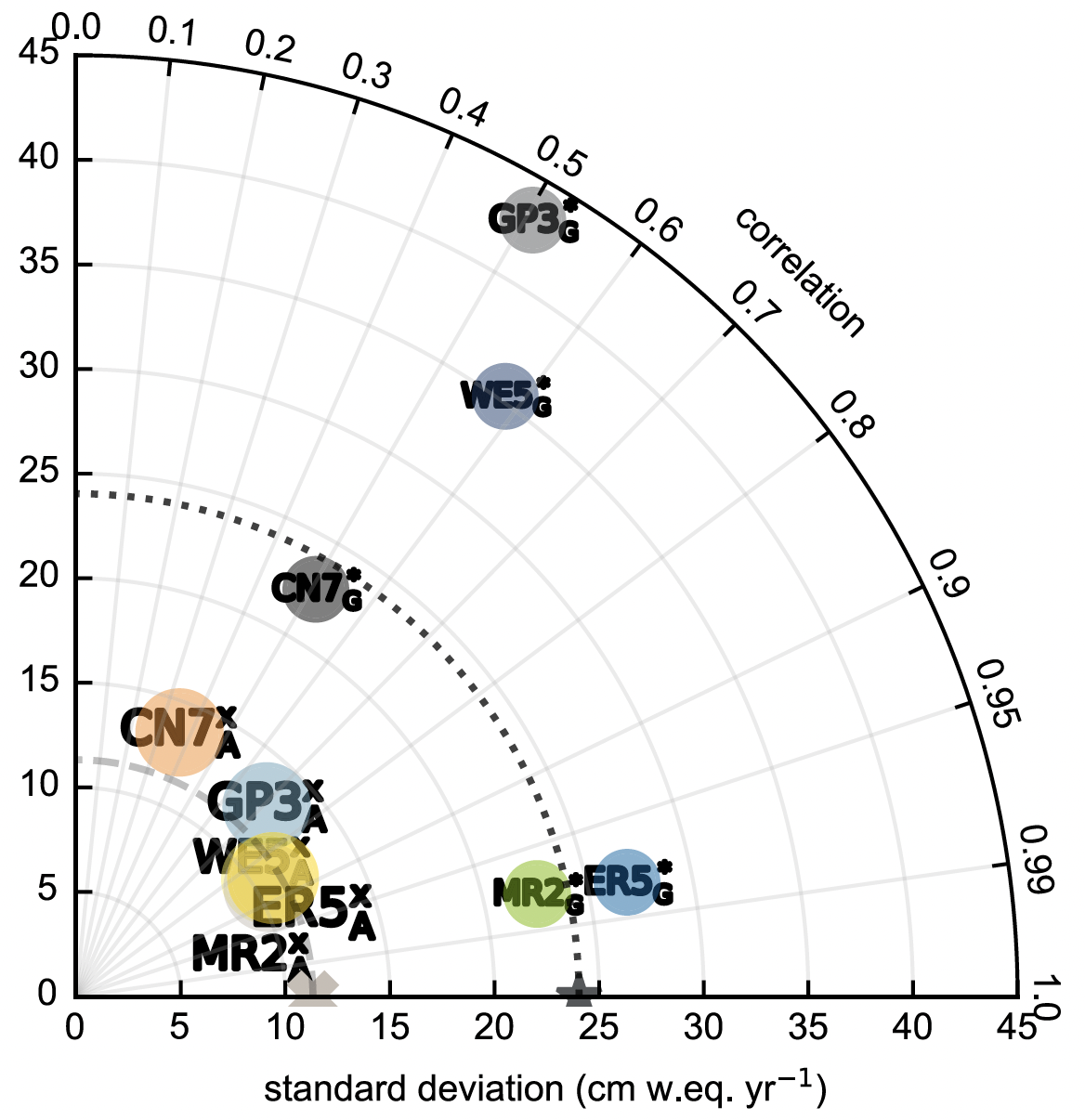First Use of Shallow Ice Cores to Constrain Precipitation Over Ice Sheets
Findings from this study led to improved E3SM ice sheet surface mass balance simulations.
The Science
The plurality of sea-level rise is due to Greenland ice-sheet (GrIS) surface melt, yet estimated ice-sheet snowfall, the source of the melt, varies widely among observational reanalyses. In this study, scientists used a database of shallow ice core measurements to identify the best reanalyses for ice sheet simulations.
The Impact
In global earth system simulations, it is important to start a simulation from a good initial condition, ideally a state in which physics and dynamics tendencies are in long term equilibrium with the unforced, pre-industrial climate. Often a long ‘spin-up’ time is needed for the simulation to reach this state. The deep snow called firn covers the polar ice sheets and accumulates for centennial (GrIS) to millenial (Antarctica) timescales before its pores close-off and it behaves more like impermeable ice. It is important to spin-up the firn in Earth System Models (ESMs) with accurate pre-industrial precipitation fields so the firn responds (e.g., melts, drains, reflects) realistically to modern climate forcing.
GrIS Surface Mass Balance (SMB), defined as accumulation minus discharge, was last in equilibrium around 1990, so researchers have long used pre-1990 observational reanalysis data as a proxy for pre-industrial precipitation rates to spin-up ESM snowpack. However, the ice sheet snowfall fields in the five most commonly used reanalyses diverge widely from one another, and had never before been intercompared and confronted with robust observations. To determine which reanalysis data set provides the best input data over Greenland and Antarctica, E3SM scientists compared precipitation from five reanalysis data sets to shallow ice core measurements that temporally resolve the annual snowfall rates from 1980-1990. Only two reanalyses (ERA5 and MERRA2) were found to provide accurate long-term precipitation fields over Greenland, indicating their superiority for ice sheet studies. The study motivated the development and implementation of ERA5 offline-forcing in E3SM’s land model (ELM) to simulate the more realistic firn depth, density, and air content that are required to project ice sheet, ice shelf, and sea-level rise responses to global warming.

Figure 1. Taylor diagram shows that European Centre for Medium-Range Weather Forecast Fifth Generation Reanalysis (ERA5, marked as “ER5”), and Modern-Era Retrospective Analysis for Research and Applications version 2 (MERRA2, marked as “MR2”) observational reanalyses best match net accumulation from SUMup ice cores on Greenland (GrIS, indicated with subscript G), Antarctica (AIS, subscript A). Markers are plotted in polar coordinates, with angles from the horizontal axis representing cosine of the correlations between reanalysis data and observations and the distances from the origin representing geographic sample standard deviations. Marker areas are proportional to the number of reanalysis-observation location pairs. Antarctic markers for ERA5, WFDE5, and MERRA-2 overlap. Sample standard deviations of the observations (which have correlations of 1 with themselves) are denoted on the horizontal axis by ∗ for the GrIS and by × for the AIS. The distances from ∗ and × represent the centered (i.e., “debiased”) RMSE resulting from the law of cosines (Taylor, 2001) for the GrIS and AIS, respectively. Dotted and dashed curves show isolines of constant standard deviations relevant to observations from the GrIS and AIS, respectively.
Summary
Sea-level rise (SLR) projections by Earth System Models (ESMs) depend on ice sheet surface mass balances. Accurate, global atmosphere reanalyses are required to provide equilibrated ice sheet model initial conditions in fully coupled ESM simulations. This study presents the first evaluation of 1980–1990 global reanalysis of precipitation over Greenland and Antarctica that uses independent observations of net accumulation rates derived from shallow ice cores (Fig. 1). Precipitation distributions from both ERA5 and MERRA-2 are highly correlated with contemporaneous co-located net accumulation rates from Greenland (r^2 > 0.95) and West Antarctica (r^2 > 0.7). Three other commonly used reanalyses (WFDE5, CRUNCEP, and GSWP3) exhibit significantly weaker correlations on one or both ice sheets. Our findings imply that ESMs should use ERA5 or MERRA-2 in data-forced simulations to validate ice sheet model dynamics and preconditions firn for SLR projections.
Publication
- Schneider, Adam Michael, Charles S Zender, Nicole Loeb, and Stephen Price. 2023. “Use Of Shallow Ice Core Measurements To Evaluate And Constrain 1980–1990 Global Reanalyses Of Ice Sheet Precipitation Rates”. Geophysical Research Letters 50 (19). American Geophysical Union (AGU). doi:10.1029/2023gl103943.
Funding
- This work was supported by the Earth System Model Development program area of the Department of Energy, Office of Science, Biological and Environmental Research program , and by the Scientific Discovery through Advanced Computing (SciDAC) program of the DOE Advanced Scientific Computing Research (ASCR) Program. This research used resources of the National Energy Research Scientific Computing Center, a DOE Office of Science User Facility supported by the Office of Science of the U.S. Department of Energy under Contract No. DE-AC02-05CH11231.
Contact
- Charlie Zender, University of California – Irvine
This article is a part of the E3SM “Floating Points” Newsletter, to read the full Newsletter check:


